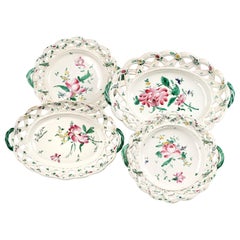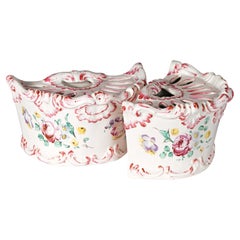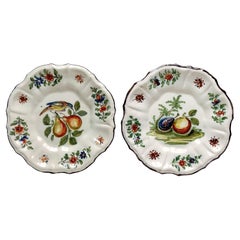Maiolica Furniture
to
12
133
18
139
14
1
29
21
8
7
7
5
4
3
2
1
76
30
33
15
10
17
4
4
2
2
5
3
4
156
356,059
295,997
232,781
149,625
144
115
13
8
5
154
152
152
11
11
9
6
5
Material: Maiolica
Italian Maiolica Tureen, Rubati Manufacture, Milan, circa 1770-1780
Located in Milano, IT
Maiolica tureen
Pasquale Rubati Manufacture
Milan, circa 1770 - 1780
Maiolica polychrome decorated “a piccolo fuoco” (third fire).
It measures 6.69 in x 11,02 x 8.26 (17 x 28 x ...
Category
1770s Italian Rococo Antique Maiolica Furniture
Materials
Maiolica
Four Italian Ancient Dishes, Antonio Ferretti, Lodi, circa 1770-1780
Located in Milano, IT
Assortment of 4 dishes with braided rim
Antonio Ferretti Manufacture
Lodi, circa 1770-1780
Maiolica polychrome decorated “a piccolo fuoco” (third fire).
Measures: 14 x 10 in (35.5 x 25.5 cm);
12.2 x 8.39 in (31 x 21.3 cm);
10.4 x 9.65 in (26.5 x 24.5 cm);
10.8 x 9.61 in (27.5 x 24.4 cm).
Weight: 4.4 lb (1.998 kg)
State of conservation: some chips due to use on the edges and on the parts in relief.
The four different dishes have a foot with a low lip from which extends a wide, flat, slanted rim resembling a basket weave. The small handles are painted green: they resemble wickerwork in the two oval dishes and take the form of a sinuous branch in the round ones.
The third fire decoration is inspired by the naturalistic floral botanical patterns on the ceramics produced by the Hannong family in Strasbourg. Here the pattern is defined by the rapidity and subtlety of the brushstrokes and the result is particularly tasteful, characterized by compositional intelligence and pictorial expertise.
A main corolla, either a wild or garden rose, is set slightly off center in each well. From this extends a thin stem holding a small secondary bud and there are small field florets dotting the composition to lend volume to the delicate bunch of flowers.
On the brim, small polychrome flowers add color to the weave, accompanied by lanceolate leaves of a very intense green.
There exist few and very rare examples for comparison with this morphology: a round plate - entirely consistent with those in question - has been dated to around 1775 (S. Levy, Maioliche settecentesche lombarde e venete, Milano 1962, tav. 200). Two other dishes with a basket rim, but with parallel striped brim decoration, were exhibited in the 1995 exhibition on Lodi ceramics; the attribution to the Lombard town near Milan is therefore almost exclusively derived from the decoration called "alla rosa contornata" or "alla vecchia Lodi" and constitutes one of the most popular decorations during the eighteenth century. (M. L. Gelmini, in Maioliche lodigiane del '700 (cat. mostra Lodi), Milano 1995, pp. 31 p. 162-163 nn. 181-182).
This decorative choice represented a strong point of the Lodi factory, which established itself thanks to the vivid nature of the colors made possible by the introduction of a new technique perfected by Paul Hannong in Strasbourg and which Antonio Ferretti introduced in Italy. This production process, called “piccolo fuoco” (third fire), allowed the use of a greater number of colors than in the past; in particular, the purple of Cassius, a red made from gold chloride, was introduced. Its use allowed for many more tones and shades, from pink to purple.
The Ferretti family had started their Maiolica manufacturing business in Lodi in 1725.
The forefather Simpliciano had started the business by purchasing an ancient furnace in 1725 and, indeed, we have evidence of the full activity of the furnaces from April of the same year (Novasconi-Ferrari-Corvi, 1964, p. 26 n. 4). Simpliciano had started a production of excellence also thanks to the ownership of clay quarries in Stradella, not far from Pavia. The production was so successful that in 1726 a decree of the Turin Chamber came to prohibit the importation of foreign ceramics, especially from Lodi, to protect internal production (G. Lise, La ceramica a Lodi, Lodi 1981, p. 59).
In its initial stages, the manufacture produced maolicas painted with the “a gran fuoco” (double fire) technique, often in turquoise monochrome, with ornamentation derived from compositional modules in vogue in Rouen in France. This was also thanks to the collaboration of painters like Giorgio Giacinto Rossetti, who placed his name on the best specimens next to the initials of the factory.
In 1748 Simpliciano made his will (Gelmini, 1995, p. 30) appointing his son Giuseppe Antonio (known as Antonio) as universal heir. After 1750, when Simpliciano passed away, Antonio was directly involved in the Maiolica factory, increasing its fortunes and achieving a reputation on a European level. Particularly important was the aforementioned introduction in 1760 of the innovative “a piccolo fuoco” (third fire) processing, which, expanding the ornamental repertoire with Saxon-inspired floral themes, could commercially compete with the German porcelains that had one of its most renowned offerings in the naturalistic Deutsche Blumen. Antonio Ferretti understood and promoted this technique and this decoration, proposing it in a fresher and more corrective version, less linked to botanical tables...
Category
1770s Italian Neoclassical Antique Maiolica Furniture
Materials
Maiolica
Maiolica flower pots Samson & Fils Factory, France, late 19th century
By Emile Samson
Located in Milano, IT
Maiolica flower pots “a mezzaluna”
Samson & Fils Factory
Montreuil-sous-Bois, France, late 19th century
They measure 4.72 in in height x 8.66 x 5.03 (12 cm x 22 x 12,8)
Weight: 1.88...
Category
Late 19th Century French Rococo Antique Maiolica Furniture
Materials
Maiolica
Two Small Italian Dishes Antonio Maria Coppellotti Manufacture, Lodi, Circa 1740
By Antonio Maria Coppellotti
Located in Milano, IT
Two small dishes
Antonio Maria Coppellotti Manufacture
Lodi, Circa 1740
High fire polychrome majolica
They measure: diameter 7.08 in(18 cm)
Weight: 0.37 lb (170 g)
State of conservat...
Category
1740s Italian Baroque Antique Maiolica Furniture
Materials
Maiolica
18th Century Italian Maiolica Centerpiece Bassano Venice, circa 1750
Located in Milano, IT
Maiolica centerpiece
Pasquale Antonibon factory
Nove di Bassano, Venice, 1740-1770.
Measures: 1.85 in x 19.21 in x 15.27 in
4.7 cm X 48.8 cm X 38.8 cm.
lb 5.29 (kg 2.4)
State of conservation: thin passing fêlure with covered chipping and a glued foot
The Antonibon were an important family of Venetian...
Category
1750s Italian Baroque Antique Maiolica Furniture
Materials
Maiolica
19th Century Liberty Gibus & Redon Polychrome Vase
Located in Firenze, FI
Characteristic four-handled polychrome majolica vase born from the artistic collaboration of Gibus and M. Redon. The object represents a fusion of Neo-Renaissance and Art Nouveau fea...
Category
1890s French Art Nouveau Antique Maiolica Furniture
Materials
Maiolica
Small Maiolica Flower Pots, Ferretti Manufacture, Lodi, circa 1770-1780
Located in Milano, IT
Two maiolica flower pots
Antonio Ferretti Manufacture
Lodi, Circa 1770 - 1780
Maiolica polychrome decorated “a piccolo fuoco” (third fire)
The...
Category
1770s Italian Rococo Antique Maiolica Furniture
Materials
Maiolica
FIRST HALF OF THE 18th CENTURY VERTICAL CASTLES MAJOLICA PLAQUE
By Castelli
Located in Firenze, FI
Beautiful vertically painted majolica plaque, attributable to the famous Castelli factory, located in Abruzzo (Central Italy), dating back to the first half of the 18th century. The ...
Category
Early 18th Century Italian Antique Maiolica Furniture
Materials
Maiolica
Ancient Maiolica Flower Pot Pasquale Rubati Factory, Milan Circa 1770
Located in Milano, IT
Maiolica flower pot “a mezzaluna” decorated with tulip
Pasquale Rubati Factory
Milan, circa 1770.
Measures: 4.7 in x 4.7 in x 8.6 in
12 cm x 12...
Category
1770s Italian Rococo Antique Maiolica Furniture
Materials
Maiolica
Laveno Angelo Biancini Maiolica Terracotta Vase, Italy, 1930
Located in Milano, IT
Laveno Angelo Biancini pair of vases 1930 Maiolica earthenware, Italy.
Category
Mid-20th Century Italian Art Deco Maiolica Furniture
Materials
Maiolica
Bas Rilief, 1950 Germano Belletti
Located in Milano, IT
Exceptional and exclusive Bas Rilief, 1950 Germano Belletti " Centauri" in Faenza, 1914 works with Pietro Melandri, Riccardo Gatti, Mario Morelli. Apprezzated to Giò Ponti.
Category
1950s Italian Other Vintage Maiolica Furniture
Materials
Maiolica, Wood
Crater Vase in Majolica Manufacture of Naples Italy Late 19th Century
By Non-Standard Furniture and Lighting
Located in Milano, IT
Large polychrome faience crater vase with serpentiform handles. Historiated decoration with mythological subject: "The Rape of Proserpine," there is also depicted the lake of Pergusa...
Category
Late 19th Century Italian Other Antique Maiolica Furniture
Materials
Maiolica
Pair of Amphorae in Maiolica Central Southern Italy Late 19th century
By Non-Standard Furniture and Lighting
Located in Milano, IT
Pair of polychrome majolica amphorae with grotesque motifs. Reserves on both sides decorated with allegorical-mythological motifs. The highly inset side handles are supported by wing...
Category
1890s Italian Other Antique Maiolica Furniture
Materials
Maiolica
Ancient Italian Maiolica Rose Dishes by Pasquale Rubati Milano, 1780 circa
Located in Milano, IT
Assortment of 12 elements with polychrome and gold decoration
Pasquale Rubati Factory
Milan, circa 1770- 1790.
Two oval trays 10.62 in x 8.58 in (27 x 21.8 cm)
Two dishes with perforated brim diameter 10.43 in (26.5 cm)
Eight round dishes 9.37 in (23.8 cm)
lb 10.14 (kg 4.6)
State of conservation: very good, except for light chips with color drops at the edges, a greater one in a round dish.
This rare set of dishes has great decorative impact and confirms the undisputed artistic ability of Pasquale Rubati's productions during the period of his greatest success. It also attests to the taste of the great Milanese commissions of the eighteenth century.
Pasquale Rubati, a refined painter, opened his own factory in Milan in 1756, in competition with Felice Clerici...
Category
1770s Italian Rococo Antique Maiolica Furniture
Materials
Maiolica
Ancient Pair Coffee Pots, Pasquale Rubati Manufacture Milan, 1770 circa
Located in Milano, IT
Pair of small coffee pots.
Manufacture of Pasquale Rubati
Milan, 1770 Circa
Maiolica polychrome decorated “a piccolo fuoco” (third fire).
a) height 7.87 x 5.51 x 3.93 in (20 x 14 x ...
Category
1760s Italian Neoclassical Antique Maiolica Furniture
Materials
Maiolica
Ancient Maiolica Coffee Set “Barbotine” Decoration Milan, 1770- 1780
Located in Milano, IT
Coffee assortment with “barbotine” decoration
Manufacture of Pasquale Rubati or Felice Clerici
Milan, 1770- 1780
Maiolica polychrome decorated “a piccolo fuoco” (third fire).
...
Category
1770s Italian Rococo Antique Maiolica Furniture
Materials
Maiolica
Important Plate Fratelli Minardi Faenza 1920 Art Deco
By Europa
Located in Madrid, ES
Important Plate Fratelli Minardi Faenza 1920
Lady's profile, a polychrome ceramic plate with a wide rim and a deep recess, with a ring-shaped support on the back, on a recessed back...
Category
Early 20th Century Italian Baroque Maiolica Furniture
Materials
Maiolica, Porcelain
Italian Maiolica Pitcher with a Rampant Lion, Center Italy , Ca 1850
Located in CH
Italian Maiolica Pitcher with a Rampant Lion, Central Italy , Ca 1850
This unmarked Maiolica Pitcher with a cream white background is decorated on the front with a cobalt blue rampa...
Category
Mid-19th Century Italian Renaissance Revival Antique Maiolica Furniture
Materials
Maiolica
Antique Italian Maiolica Coolers Pasquale Rubati Manufacture Milan, 1770 Circa
Located in Milano, IT
Assortment of bottle and glass coolers in Maiolica.
Pasquale Rubati manufacture
Milan, circa 1770
Maiolica polychrome decorated “a piccolo fuoco” (third fire)
a - Bottle cooler
5.91 in x 5.91 in diameter (15 x 15 cm )
Weight: 1.86 lb (845 g)
b - Bottle cooler
6.89 x 7.87 in diameter (17,5 x 20 cm)
Weight: 2.09 lb (948 g)
c - Pair of glass-cooler vases
3.94 x 3.94 in diameter (10 x 10 cm)
Weight: 1.43 lb (650 g)
Good state of conservation:
a - some chipping from use on the edge;
a - two fêlures covered on the edge;
c - one has deep chippings on the edge and the other a subtle fêlure.
Two Majolica factories were active in Milan in the 18th century. The first, starting from 1745, was owned by Felice Clerici; the other one by Pasquale Rubati from 1756. Rubati was in competition with Felice, whose worker he had been prior to opening his own workshop. On his death in 1796, the business was continued for a few more years by his son Carlo.
Recent studies have recognized Pasquale Rubati's contribution as the creator of "Strasbourg-style" decorations with their particularly joyful depictions. This style had previously been attributed to the Lodi manufacturers. These works here, however, are a clear example of this production.
The Majolica containers have different sizes, a cylindrical shape and rest on a low foot ring. The two largest are completed by handles in the shape of a zoomorphic mask with wide open jaws, while the smaller ones have handles applied with an anthropomorphic mask.
All the works are characterized by elegant floral decoration.
The two twin glass coolers show bunches of flowers centered around a main corolla, a rose or a peony paired...
Category
1770s Italian Rococo Antique Maiolica Furniture
Materials
Maiolica
Maiolica Oval Tray, Felice Clerici Manufactory, Milan, Circa 1770-1780
Located in Milano, IT
Small oval tray
Felice Clerici Manufactory 1745-1780
Milan, Circa 1770-1780
Maiolica polychrome.
Dimensions: 10.82 x 8.66 in (27.5 x 22 cm); weight 0.4...
Category
1770s Italian Rococo Antique Maiolica Furniture
Materials
Maiolica
Apollineo Contemporary Table Mirror in Leccese Stone and Hand-Painted Maiolica
By TIPSTUDIO
Located in Florence, IT
The Apollineo collection merge classical and contemporary elements to define a unique aesthetic inspired by Mediterranean architecture and v...
Category
2010s Italian Modern Maiolica Furniture
Materials
Stone, Limestone
$932 Sale Price / item
20% Off
Pair of Ancient Italian Maiolica Flower Pots Milan, Rubati Factory, 1770 circa
Located in Milano, IT
Maiolica flower pot “a mezzaluna”
decorated with trompe l’oeil
Pasquale Rubati Factory
Milan, circa 1770
Measures: each 4.7 in (cm 12) x 5 in (c...
Category
1770s Italian Rococo Antique Maiolica Furniture
Materials
Maiolica
17th Century Italian Deruta Maiolica Salt
Located in Basildon, GB
17th Century Italian Deruta Maiolica Salt, probably made in Caltagirone in Sicily, the central circular dish within four scroll dishes supported by a Sphinxes and lions on on a cross...
Category
Late 17th Century Italian Baroque Antique Maiolica Furniture
Materials
Maiolica
$6,762 / item
Coppia di specchierine veneziane in maiolica del Settecento
Located in Vicenza, IT
Questa bellissima coppia di specchierine in maiolica furono realizzate in Veneto nel XVIII secolo.
Hanno cornice sagomata in maiolica bianca con fiori arricchiti da dorature.
Alla b...
Category
Mid-18th Century Italian Louis XV Antique Maiolica Furniture
Materials
Ceramic, Maiolica, Porcelain
Four Italian majolica pitchers
Located in Milano, IT
The four majolica pitchers can be traced to the Renaissance period and an Italian production. Specifically, three of them were produced in Faenza between the 15th and 16th centuries ...
Category
16th Century Italian Renaissance Antique Maiolica Furniture
Materials
Maiolica
Apollineo Bookend 2 in Leccese Stone and Hand-Painted Ceramic
By TIPSTUDIO
Located in Florence, IT
The Apollineo collection mergs classical and contemporary elements to define a unique aesthetic inspired by Mediterranean architecture and vibes. Sun-blessed pure volumes, shapes mar...
Category
2010s Italian Modern Maiolica Furniture
Materials
Stone, Limestone
Tuscan-made majolica Boxer breed dog, Italy, 1960s
Located in Vicenza, VI
Majolica depicting a Boxer breed dog of Tuscan manufacture, executed around 1960s. It measures 28x52x78 cm and is airbrushed, coated, modeled and finished by hand.
Majolica is a ty...
Category
1960s Italian Other Vintage Maiolica Furniture
Materials
Maiolica
Stunning Italian Maiolica Ceramic and Brass Ceiling Lamp with four glass shades
Located in Mexico, DF
Beautiful long ceiling lamp in brass with two magnificent pieces of Italian maiolica ceramics in gold, cream, and green hues. One ceramic piece is pa...
Category
Early 20th Century Italian Neoclassical Revival Maiolica Furniture
Materials
Brass
Large bowl, Aldo Londi for Bitossi, 1950s
By Bitossi, Aldo Londi
Located in Firenze, IT
Beautiful, large bowl designed by Aldo Londi for Bitossi, for which he was art director, in the early 1950s. It is molded with refractory earth in shades of brown with a rather rare ...
Category
1950s Italian Mid-Century Modern Vintage Maiolica Furniture
Materials
Ceramic, Maiolica
Handcrafted Majolica Garden Figure - Monkey on a basket of fruit, handpainted
Located in München, Bavaria
This figure of a monkey sitting on a basket of fruit is a wonderful example of Josef Wackerle´s sculpting skills. The character of the monkey, sitting and ready to throw the fruit, i...
Category
21st Century and Contemporary German Modern Maiolica Furniture
Materials
Maiolica, Majolica
Apollineo Bookend 1 in Leccese Stone and Hand-Painted Ceramic
By TIPSTUDIO
Located in Florence, IT
The Apollineo collection mergs classical and contemporary elements to define a unique aesthetic inspired by Mediterranean architecture and vibes. Sun-blessed pure volumes, shapes mar...
Category
2010s Italian Modern Maiolica Furniture
Materials
Stone, Limestone
Apollineo Column Vase in Leccese Stone and Hand-Painted Ceramic
By TIPSTUDIO
Located in Florence, IT
The Apollineo collection mergs classical and contemporary elements to define a unique aesthetic inspired by Mediterranean architecture and v...
Category
2010s Italian Modern Maiolica Furniture
Materials
Stone, Limestone
$512 Sale Price
20% Off
Apollineo Arena Centerpiece in Leccese Stone and Hand-Painted Maiolica
By TIPSTUDIO
Located in Florence, IT
The Apollineo collection mergs classical and contemporary elements to define a unique aesthetic inspired by Mediterranean architecture and vibes. Sun-blessed pure volumes, shapes mar...
Category
2010s Italian Modern Maiolica Furniture
Materials
Stone, Limestone
$666 Sale Price
28% Off
Apollineo Candle Stand in Leccese Stone and Hand-Painted Ceramic
By TIPSTUDIO
Located in Florence, IT
The Apollineo collection mergs classical and contemporary elements to define a unique aesthetic inspired by Mediterranean architecture and v...
Category
2010s Italian Modern Maiolica Furniture
Materials
Stone, Limestone
$316 Sale Price / item
20% Off
Recently Viewed
View AllMore Ways To Browse
Hotel Silver
Japanese House
Hand Painted Wood Panel
Italian Rattan Furniture
Heart Wood Furniture
High End Antique Furniture
Green Coat
Italian Bronze Table
Grand Central
Glass Art Waves
Italian Villa
Gothic Antique Furniture
Hand Painted Antique China
Japan Box
Heavy Carved Furniture
Italian Relief
Geometrical Models
Italian Inlay Furniture





